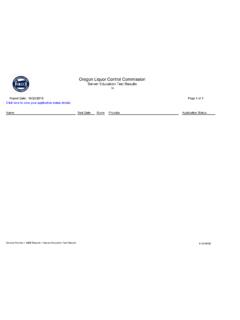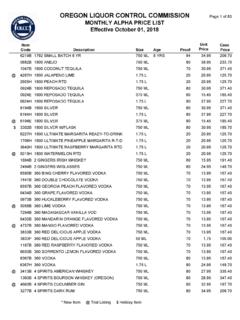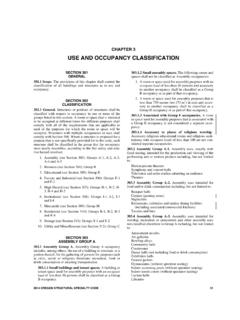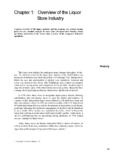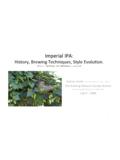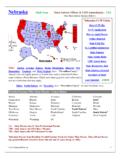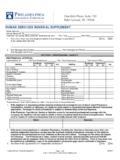Transcription of Mead Family Ancestry
1 MEADFAMILY ANCESTRYbyJim German1 MEAD Family Ancestry Jim German, Mead Ancestry can be found in the days of the Norman Conquest of the 11th century. However, at that time the Mead name was not used as we know it today. It was more a descriptive word, coming from the Norman word, de Prato, meaning of the meadow, which described where a person lived, the flat lands or a meadow. Over the centuries the word became more associated as a proper name, than as a descriptive name. It wasn t until about 800 to 900 years ago that proper (last) names as we know them became common usage. Given this, there are many Mead families in England and Ireland that are not related to each other unless we go back to Adam and Eve. This can also be true of Mead families in America. Tracing the Mead s in England past the 1500 s is very difficult, as documentation is difficult to piece together, or is nonexistent.
2 Throughout the history of England, there are many Meads filling the ranks of the upper classes, as well as the middle class. Given to the chances, there may have been some in the lower classes, but it seems our known Mead Ancestry falls into the middle class, which usually included the people working as tradesmen or operating businesses. The following is an excerpt from the book titled History and Genealogy of the Mead Family , by Spencer P. Mead, copyright, 1901. In 1180 to 1195 there is to be found in the ancient Norman records the names of William, Robert, Matilda, and Reginald de Prato, and in 1198 the names of Richard, and Robert de Prato. In 1199, Essex, England, occurs the name of Roger de Prato, and the same year also that of Walter de Prato in Hertfordshire, England, and in 1272 those of Stephen and Peter de Prato, England. Hervey de Prato, in 1200 in Normandy, was King John s Faithful Knight, and the custody of Rouen Castle was given to his brother.
3 In that book, it goes on to detail many Mead s in high positions in English history. 311TH GREAT GRANDPARENTSOur earliest Mead ancestors traced with certainty are Richard Mead and Martha Gouldhurst, of Watford, Hertfordshire, England. Richard was born about the year 1515, during the reign of King Henry VIII. It is believed by some, that Richard s father was Timothy Mead, with two more Timothy s preceding him. Not enough documentation has been found to substantiate their claim, and therefore it is speculation at best. There are records of these Timothy s, but none other than the common location, that tie them to Richard. Watford is a town located about fifteen miles northwest of present day London in the county of Hertfordshire. The Meads of Watford were known as Mealmen, a term that explains their profession as millers of GREAT GRANDPARENTSP ricilla Mead and Dorothy Grey, our 10th great grandparents, lived in Watford, England.
4 Other than being a mealman, dealing in the raising and grinding of grain, nothing much is known about them. The name Pricilla today is decidedly feminine, but at that time it was established as a male and female name. 9th GREAT GRANDPARENTSOur ancestors who immigrated to America were Richard and Martha s grandson, William Mead and his wife Philippa Kilvey, our generation s ninth great grandparents. They came with their children Joseph, John, and Martha. Another daughter, Mary the eldest of their children, died before they left England. Philippa s last name of Kilvey is possibly incorrect but is what some researchers have settled on. The Mead Family is purported to have left from Lydd, Kent County, England aboard the ship The Elizabeth, believed to be in the company of Pastor Richard Denton and his Watford entourage, in April of 1635. They arrived in Plymouth Colony in June of 1635.
5 Their voyage had been a hard one, with scant provisions, and cramped accommodations, very typical of crossings at that time. It wasn t until the late 1800 s that passage became more did not come to America for religious freedom, as a lot of early settlers had, but to build a new life in a new country. William was not tolerant of the straight laced people of Boston, nor did he care for the organized religions and their harsh doctrines. In 1636 discontent manifests itself around Boston, and Rev. Thomas Hooker, Roger Williams and Mrs. Hutchinson lead a revolt against the established church and left Massachusetts bound for Rhode Island, and Connecticut. This left only about eleven families still in Cambridge. With the many families that revolted from this environment, William and Philippa joined the group of Massachusetts Bay Colonists, led by Roger Williams, and moved to Connecticut.
6 Connecticut and Rhode Island, though strict by today s standards, were not ruled by the tyrannical oligarchy of the Massachusetts government, and offered more religious and personal freedoms for those that moved there. It is here where you see the attempt to separate the government from the church. These Connecticut Colonists, tired of the church control into their everyday lives, set up their governing body separate from the rule of the church. Their attempt probably wasn t any better for the colonists, but does show the start of a basis for the American Constitution, separating Church and State. William and his Family first settled in Wethersfield, Connecticut, which is near Hartford and was under the jurisdiction of the Connecticut Colony. On December 7, 1641, they moved to and established Stamford, Connecticut, with forty one other families. Stamford was under the rules of the New Haven Colony.
7 There William was granted five acres and a town lot, a place to build his home. William Mead, the immigrant, was a well respected man of early colonial Connecticut. William was very active in the governmental proceedings of Stamford, Connecticut, and left his mark throughout his community, and in history. He was the ancestor to most of the Mead s of Connecticut, New York, Vermont and those that settled Meadville, Pennsylvania. It is said over a million Americans have William s blood flowing in their veins. Our own Mead ancestral line evolved from those that settled first in Connecticut, 4then western New York, Ohio, Indiana and then to s wife Philippa died of malaria in Stamford, on September 19, 1657. A memorial in Tomac Burying Ground, in Old Greenwich, Connecticut, in memory of the Mead Family , only mentions William and his three children, Joseph, John, and Martha, leaving Philippa s burial place descendants of William Mead, through his son John, are Major General John Mead IV, Revolutionary War soldier.
8 Major General James Mead of the Revolutionary War, and subsequent co-founder of Meadville, Pennsylvania. Major General Ebenezer Mead, Revolutionary War, and the War of 1812. Major General David Mead, war of 1812, and co-founder of Meadville, Penn. General Thompson Mead of the War of 1812. Amos Mead, (Surgeon) Esquire, French and Indian War, member of the Continental Congress for Fairfield County, Connecticut, and signer for the ratification of the United States Constitution. Amos was a great grandson of John Mead I. Dr. Elwood Mead, (b. 1858, Indiana) Director of the Dept. of the Interior. As director of the Interior, he was overseer of the construction of Hoover Dam on the Colorado River, Grand Coulee Dam on the Columbia River in Washington, and Owyhee Dam on the Owyhee River in Eastern Oregon. With his accomplishments, he was honored to have Lake Mead named for him.
9 Among many other accomplishments in his career, he also oversaw water projects in Australia, and Israel. Generals John and James Mead are our generation s first cousins seven times removed, and Elwood Mead is our seventh cousin three times removed. General Thompson Mead is our third cousin, six times removed. General Ebenezer Mead is our third cousin, six times removed. General David Mead assisted Commodore Perry of the Navy, in squashing a British attack at Erie, Pennsylvania during the War of 1812. Amos Mead is our second cousin, seven times removed. Early in the Colonial period, defense from attacks by Indians was developed by organizing militia groups, sometimes called train bands. Train was a term shortened from the word trained. All able men, including our Mead ancestors, were required to participate in the defense of their community, as well as when needed, in the Colonies as a whole.
10 These settlers were required to attend scheduled training, and keep at the ready, a rifle, powder, bullets, and match. Certain members of these train bands were also required in turn, to be at a moment s notice, ready for a call to service. These became known as the minutemen. The command structure in the early days was by appointment, usually by the local governing body. Later a common practice was by election by the members of the militia. These militias and the need for them placed the Colonies in the ready, when the Revolutionary War broke the English came to Connecticut in the 1600 s, the Dutch were in control of that part of southwest Connecticut in which the Mead s settled. With a history of the Dutch people supplying fire water to the Indians, and the Indians resultant rampages against the settlers, there were continuous skirmishes between the two groups. The many massacres that occurred on both sides eventually subsided when the Indians dwindled in numbers.
